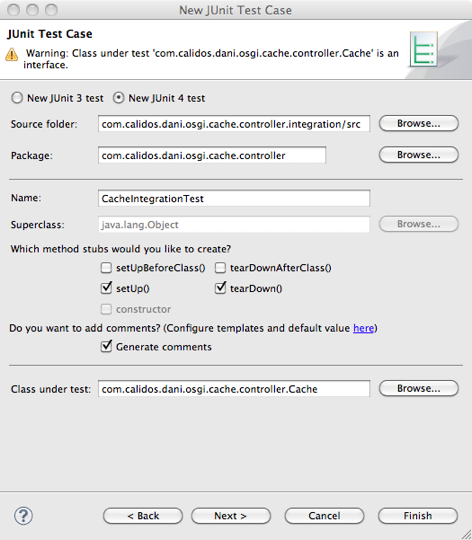In this installment of the server-side OSGi series, we add integration testing capabilities to our project. Integration testing goes beyond plain unit testing and checks the interactions between real components. This is in contrast with unit testing, which generally uses mockups to represent components outside the one being tested. Please take a look at previous installments, as usual.
In the case of integration testing, it is manly used in a pre-production environment, with a valid build that has all unit tests passed. It can even be used in production to just after a deployment is made, taking care not to have destructive checks or massive load tests in the integration test code. YMMV.
To achieve integration testing we need to check the various OSGi components deployed interact in the way that is expected of them. Therefore we need to test the components in a group and not in isolation. To do that in the OSGi world means we need to have access to the OSGi context from within the tests to access services, call them and check their responses, etc.
To allow for this kind of integration testing within the OSGi environment, we make a slight modification to the excellent test.extender we have already patched in the previous installment.
Basically, the basic test.extender seeks out any JUnit test classes within the fragment bundle, creates an instance using an empty constructor and then fires up the tests. This is activated either by default when the fragment is loaded or by using ‘test
For our integration testing, we add an extra command to test.extender:
public Object _integrationTest(CommandInterpreter intp) {
String nextArgument = intp.nextArgument();
testExtender.integrationTest(Long.parseLong(nextArgument));
return null;
}
And we refactor the TestExtender to add the integrationTest method which reuses some of the code to instantiate test cases using a constructor that accepts the OSGi context as a parameter.
Constructor[] constructors = clazz.getConstructors();
boolean foundConstructor = false;
for (int i = 0; i < constructors.length && !foundConstructor; i++) {
Constructor constructor = constructors[i];
Class[] types = constructor.getParameterTypes();
if (types.length==1 && types[0].isInstance(context)) {
foundConstructor = true;
EClassUtils.testClass(inspectClass, constructor.newInstance(context));
}
} // for
The OSGi context is passed onto the constructor and then the test class is run. It is obviously up to the test class to use the context appropriately for its integration testing.
In our cache project setup, we can do some useful integration testing on the cache.controller component, basically checking if the interaction with the provider components is behaving as we expect it. The integration testing is also added to a fragment that can be deployed optionally, of course.
We start by creating the fragment and adding a testing class like this:

Next, we add the constructor that accepts an OSGi context, which is very simple:
public CacheIntegrationTest(BundleContext ctx) {
super();
this.context = ctx;
}
In the setup and teardown methods we get and unget the cache service to perform the testing:
public void setUp() throws Exception {
serviceReference = context.getServiceReference(Cache.class.getName());
controller = (CacheControllerCore) context.getService(serviceReference);
}
public void tearDown() throws Exception {
context.ungetService(serviceReference);
controller = null;
}
In this case we get the controller cache service and store it in an instance used to perform the tests. This is quite simple and fulfills our intended purpose but we still have the flexibility to make more complex integration testing if needed.
Next we create as many test cases as needed:
public void testGet() {
try {
controller.init();
double v = Math.random();
String k = "/k"+v;
controller.set(k, v);
assertEquals(v, controller.get(k));
} catch (CacheProviderException e) {
e.printStackTrace();
fail(e.getMessage());
}
}
It should be noted that while the code looks like regular testing code, it is actually using real services from the OSGi environment as opposed to mockups. This means we are testing the real integration between components as well as the individual controller component code. The disadvantage here is that if there is an error in the controller we might mistake the problem with an issue with the services used. In conclusion, having integration code doesn’t negate the need to have unit tests.
Once we load the fragment onto the environment, first we need to obtain the bundle id of the integration fragment and then launch the integration testing in this manner:
osgi> integrate 125
Bundle : [125] : com.calidos.dani.osgi.cache.controller.integration
_
CLASS : [com.calidos.dani.osgi.cache.controller.CacheIntegrationTest]
___________________________________________________________________________
Method : [ testInit ] PASS
Method : [ testInitInt ] PASS
Method : [ testSize ] PASS
14:21:43,077 WARN CacheControllerCore Couldn't clear some of the provider caches as operation is unsupported
14:21:43,077 WARN CacheControllerCore Couldn't clear some of the provider caches as operation is unsupported
Method : [ testClear ] PASS
Method : [ testSet ] PASS
Method : [ testGet ] PASS
Method : [ testGetStatus ] PASS
___________________________________________________________________________
The results tell us that all operations are OK but we need to bear in mind that the clear operation is not supported in some backend caches. If this is what is expected by the operator then all is fine.
We take advantage of the new integration testing functionality to make some extensive changes to logging and exception handling of the controller code. By running the integration tests we make sure all seems to work fine (even though we still need some proper unit testing of the controller). Modifications are made quite quickly thanks to the integration tests.
To recap, we’ve added integration testing support to the existing ‘test.extender’ bundle and created integration testing code for the cache controller component. This has allowed us to make code changes quickly with less risk of mistakes.
Here you can find a patch for the test extender project as well as the patched testing bundle already compiled. Enjoy!